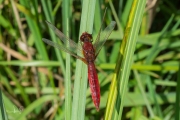The dragonfly season is in full swing. In mid-April it breaks loose when these wonderful creatures start to emerge. Some with slender bodies and others larger and much heavier built, humming like helicopters. Their splendid array of colour encompassing all the colours of the rainbow. The delicate wings and this head with those enormous facet eyes. Their thin legs with which they hold on to a leaf or a twig. And the way they fly and float. Dragonflies have something alien and at the same time prehistoric. Fascinating creatures!
Damselflies and dragonflies
The term dragonfly needs some clarification because the order of the dragonflies (Odonata) is divided into two sub-orders, namely the damselflies (Zygoptera) and the ‘real’ dragonflies (Anisoptera). The names already hides the outward difference of the two. Damselflies are delicate, fragile and move like true damsels. The dragonflies, on the other hand, are large and sturdy, real dragons.
Like-winged
We know the damselflies as the slender species such as the blue-tailed damselfly or common bluetail (Ischnura elegans), the white-legged damselfly (Platycnemis pennipes) and the beautiful banded demoiselle (Calopteryx splendens). They have a thin, long abdomen and their wings all have the same shape. Hence also the scientific name Zygoptera of this group, which means ‘equal-winged’. When damselflies are at rest, they usually fold their wings along or above the abdomen, so you will rarely see them with spreaded wings. Another striking point is that the eyes are placed on the sides of their heads and don’t touch each other. If you look from the front you see two convex facet eyes placed on both sides of a small head. Within the suborder of the damselflies we count four different families in the Netherlands: the broad-winged damselflies (Calopterygidae), the spreadwings (Lestidae), the narrow-winged damselflies (Coenagrionidae) and the white-legged damselflies (Platycnemididae).
Unequal-winged
If the damselflies are like-winged, then the real dragonflies will probably be the unequal-winged. And that’s right. The four wings of the dragonflies are not all uniform, but the rear wings are wider at the base than the front wings are. And that’s where the scientific name comes from, because Anisopteraliterally means ‘unequal winged’. Unlike the damselflies, they usually keep their wings spread out or even slanted downwards. But rarely along or above the abdomen like damselflies do. Dragonflies are also a lot firmer built. They don’t have that long thin body of a damselfly, with the dragons it is a lot wider. Dragonflies have big eyes at the front of their head, which – almost – touch each other.
Exception to the rule
The Dutch dragonflies are divided into five families: the hawkers (Aeshnidae), the clubtail dragonflies (Gomphidae), the spiketails (Cordulegastridae), the emerald dragonflies (Corduliidae) and the skimmers (Libellulidae). Incidentally, the clubtail dragonflies are an exception to the rule that the eyes of dragonflies – almost – touch each other. In this family, the eyes are a long way apart, as you can see in the common clubtail (Gomphus vulgatissimus).
Large red damselfly or Broad scarlet
Beautiful and striking examples to demonstrate the difference between a damselfly and dragonfly are the large red damselfly (Pyrrhosoma nymphula) and broad scarlet (Crocothemis erythraeae). Both species occur in the Netherlands and are predominantly red coloured.
Large red damselfly
The large red damselfly belongs to the family of the narrow-winged damselflies. It is a very common species, which you can find all over the Netherlands. It is one of the first damselflies you see in spring. They fly from late March to early September, culminating in May and June. This species is quite large, at least for damsel concepts, with body length of up to 35 millimeters. Their abdomen is red, to which the damsel also owes its name. The pterostigmas, which are the spots on the wing leading edge, are dark grey to black. You could confuse the large red damselfly with the small red damselfly (Ceriagrion tenellum), which really has a blood-red abdomen. It also has light red to orange legs and those of the large red damselfly are black.
Broad scarlet
The broad scarlet belongs to the skimmer family. Other representatives of this large family include the vagrant darter (Sympetrum vulgatum), broad-bodied chaser (Libellula depressa) and the rare lilypad whiteface (Leucorrhinia caudalis). The broad scarlet is just a little bigger than the large red damselfly at 35 to 45 mm. The abdomen is quite wide. Everything on this dragonfly is colored red, from eyes to abdomen and from legs to bust. Except for the wings, although the veins are also reddish brown in color. In the base of the rear wings, so close to the body, there is an orange spot. The pterostigmas are quite large and yellow-coloured with black edges.
So don’t just say dragonfly the next time you see one flying. You might be deeply insulting a damsel.


















